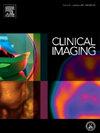Multiparametric MRI and clinical factors for predicting early recurrence of breast cancer after modified radical mastectomy
IF 1.5
4区 医学
Q3 RADIOLOGY, NUCLEAR MEDICINE & MEDICAL IMAGING
引用次数: 0
Abstract
Objective
To determine whether preoperative multiparametric MRI features and clinicopathological factors can predict early recurrence in breast cancer patients following modified radical mastectomy (MRM).
Materials and methods
This retrospective study included 132 patients who underwent MRM at two hospitals from January 2012 to December 2022. Patients were classified into early recurrence (disease-free survival ≤3 years, n = 86) or late recurrence (>3 years, n = 46). We collected preoperative MRI features (tumor size, morphology, enhancement patterns, apparent diffusion coefficient (ADC) values, early enhancement rate, time-signal intensity curves) and clinical/pathological factors (age, menstruation status, neoadjuvant chemotherapy, T/N/TNM stage, tumor grade, axillary nodal involvement, vascular/nerve/nipple/skin invasion, ER, PR, HER-2, Ki-67, molecular subtype, and adjuvant therapies). Univariate and multivariate analyses (binary logistic and Cox regression) identified independent predictors of early recurrence and their impact on disease-free survival. Predictive accuracy was assessed by ROC curves.
Results
Significant factors associated with early recurrence (P < 0.05) included tumor size, ADC value, early enhancement rate, axillary lymph node metastasis, T and TNM stage, vascular invasion, ER, PR, HER-2, molecular subtype, and endocrine therapy. Multivariate analysis identified early enhancement rate, lower ADC value, and larger tumor diameter as independent predictors (AUC = 0.899). These MRI factors, together with lack of endocrine therapy, also independently influenced disease-free survival.
Conclusion
Preoperative multiparametric MRI features, especially early enhancement rate and tumor size, combined with endocrine therapy status, can predict early recurrence, enhancing prognosis for patients undergoing MRM.
多参数MRI及临床因素预测乳腺癌改良根治术后早期复发
目的探讨术前多参数MRI特征及临床病理因素对乳腺癌改良根治术(MRM)术后早期复发的预测价值。材料和方法本回顾性研究包括2012年1月至2022年12月在两家医院接受磁共振成像的132例患者。患者分为早期复发(无病生存期≤3年,n = 86)和晚期复发(≤3年,n = 46)。我们收集了术前MRI特征(肿瘤大小、形态、增强模式、表观扩散系数(ADC)值、早期增强率、时间信号强度曲线)和临床/病理因素(年龄、月经状况、新辅助化疗、T/N/TNM分期、肿瘤分级、腋窝淋巴结累及、血管/神经/乳头/皮肤侵犯、ER、PR、HER-2、Ki-67、分子亚型和辅助治疗)。单因素和多因素分析(二元逻辑和Cox回归)确定了早期复发的独立预测因素及其对无病生存的影响。以ROC曲线评估预测准确度。结果肿瘤大小、ADC值、早期增强率、腋窝淋巴结转移、T、TNM分期、血管侵犯、ER、PR、HER-2、分子亚型、内分泌治疗与早期复发相关(P < 0.05)。多因素分析发现早期增强率、较低的ADC值和较大的肿瘤直径是独立预测因子(AUC = 0.899)。这些MRI因素,加上缺乏内分泌治疗,也独立影响无病生存。结论术前MRI多参数特征,尤其是早期增强率和肿瘤大小,结合内分泌治疗情况,可预测MRM患者早期复发,提高预后。
本文章由计算机程序翻译,如有差异,请以英文原文为准。
求助全文
约1分钟内获得全文
求助全文
来源期刊

Clinical Imaging
医学-核医学
CiteScore
4.60
自引率
0.00%
发文量
265
审稿时长
35 days
期刊介绍:
The mission of Clinical Imaging is to publish, in a timely manner, the very best radiology research from the United States and around the world with special attention to the impact of medical imaging on patient care. The journal''s publications cover all imaging modalities, radiology issues related to patients, policy and practice improvements, and clinically-oriented imaging physics and informatics. The journal is a valuable resource for practicing radiologists, radiologists-in-training and other clinicians with an interest in imaging. Papers are carefully peer-reviewed and selected by our experienced subject editors who are leading experts spanning the range of imaging sub-specialties, which include:
-Body Imaging-
Breast Imaging-
Cardiothoracic Imaging-
Imaging Physics and Informatics-
Molecular Imaging and Nuclear Medicine-
Musculoskeletal and Emergency Imaging-
Neuroradiology-
Practice, Policy & Education-
Pediatric Imaging-
Vascular and Interventional Radiology
 求助内容:
求助内容: 应助结果提醒方式:
应助结果提醒方式:


